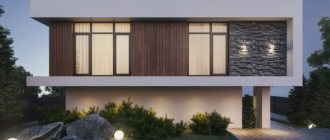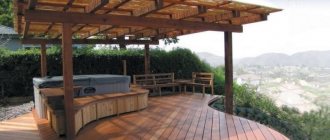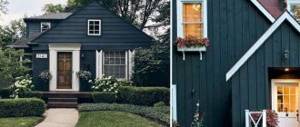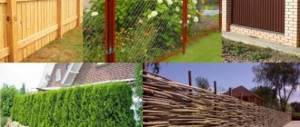Block containers are sometimes used to build small country houses and cottages. Their light weight allows you to save up to 20% on foundation construction. For such buildings, a block or pile-screw foundation is suitable. In addition, the modular houses themselves, being practically ready-to-move-in blocks, have a significantly lower cost than brick or wooden ones. You can build a house from containers as seasonal housing for a summer residence, and even as a full-fledged heated room for living in the winter.
Advantages and disadvantages of container houses
Modular houses made from block containers are ready-made buildings and do not require architectural approval, which is also important in terms of cost. Block containers are already equipped with all communication elements and only need to be connected. By combining several modules, you can create buildings of different configurations for any needs .
You can build a country house or a full-fledged home from containers
Another advantage of block structures is their mobility. They can be transported anywhere using different types of transport, and can also be quickly assembled and dismantled. Modular houses can be adapted to any climatic conditions; they are used at temperatures from -70 to +60 degrees and wind speeds of up to 125 km per hour.
The main advantages of building block containers:
- The construction of houses from block containers is carried out in a short time - from a week to a month.
- Possibility to insulate the inside and use the housing in winter.
- You can make a lightweight foundation for a house on blocks and piles.
- Possibility to carry out construction all year round.
- Mobility, ease of transportation of containers.
- Finished finishing inside the modules, attractive appearance.
- Fast construction and dismantling if necessary.
- Fire retardant coating inside and outside the container.
- Possibility to adapt housing to any climatic conditions.
Container buildings can be used at any time of the year
- Interior finishing with modern high-quality materials.
- Quick and easy connection of water supply and electricity.
- Possibility of installing a heated floor system.
- Durability of block containers, allowing to extend their service life up to 50 years
- Relatively inexpensive cost of assembly work, the ability to build an economical foundation. The mass of the blocks is small (2-4 tons) and does not require strengthening the foundation.
- Possibility of free layout and creation of intricate designs.
- Exact matching of internal dimensions. The walls of such structures are vertical; they do not require leveling or finishing work.
- Strength of walls and protection from burglars.
You can build a house of any configuration from containers
Flaws:
- High thermal conductivity of the housing, the need for additional insulation.
- Emission of solvent vapors when the housing is heated.
- Tightness, lack of natural ventilation.
Container house by Benjamin Garcia
The architect is confident that building houses can be made less expensive and still achieve maximum effect. People often build buildings with such area that it is simply not needed. Not every person wants to show their social status and prove to the world how rich you are.
For lovers of quiet country life, Garcia offers another option. What his container houses look like, photos and projects, construction prices can be seen on the Internet. A house made of 2 sea containers with everything necessary for life will cost only 40 thousand dollars.
This cost can be reduced through properly selected finishing, furniture, and construction materials. The Garcia project in particular attracts with its huge panoramic windows, compactness, and technical content. The house does not take up much space on the site. At any time you can admire the garden without leaving the house, enjoy the comfort and sunrise in the morning.
Domestic companies can develop a similar house project or offer their own version. Today, some asceticism is becoming fashionable. By calculating all the options, you can build a house for the price of a one-room apartment in the regional center of the country. The main expenses will go to the purchase of land, design, and purchase of materials. For the provinces, for example, building houses from containers is an option to save money, but not deny yourself modern beauty.
Houses made from containers fit perfectly into landscape design and save space on the site, but you should think about heating. A large volume of glass in a room can become a source of heat loss, so you need to think about how to handle this already at the design stage.
The example of these architects was followed by hundreds of specialists around the world. Today, container houses are used as living quarters, as a summer house, as an office, as cafeterias and fast food establishments. Such real estate is inexpensive to build, it does not release toxins into the environment, and has a long service life.
Container options
There are two main types of containers that are most often used for building houses. Their length is 20 and 40 feet, and their weight is 2.3 and 3.9 tons.
There is another type of container - the 45-foot design, which has come into use in the last few years. It can be transported on regular trailers, but unlike its less competitive cousins, it provides a huge working space. With its advent, the conventional semi-trailer began to be used less frequently, which led to increased competition between cargo transportation companies.
The container is made of durable steel alloy, which makes it possible to install it in several rows. However, in private construction, the creation of tall structures is impractical .
The variety of options for shipping containers is not limited to 20, 40 and 45 foot blocks. There are specialized containers: tanks for gaseous and liquid substances, refrigerators, platforms, boxes for transporting animals.
Interesting options for houses from block containers
It’s not at all difficult to build an inexpensive but interesting country house from block containers. You can purchase one or two containers and arrange them in a T or L shape, place them parallel and create a spacious, maximally glazed room between them. Use one of the blocks for bedrooms, and make a kitchen and bathroom in the second. Build the middle room as a living room. If you build a sloping roof over such a house, the ceiling of the main room will be higher than the rest.
An interesting facade will be created if two or more containers are moved relative to each other.
For a large family, you can make a country house from three block containers arranged in a U shape. In the patio, you can create a glass ceiling or build pergolas entwined with grapes or climbing flowers.
If the area of the site is so small that it is impossible to place two containers side by side, then they can be placed one on top of the other. In this case, the upper floor can be either completely autonomous with an external staircase, or connected to the lower one.
In a small area you can build a two-story house from containers
The undoubted advantage of such houses is their compactness and the ability to place them on a small, and sometimes non-standard, plot of land . Features of pile and columnar foundations are the ability to build such a foundation on literally any surface. The container can be equipped for living in areas with any climate: the walls can be insulated and a modern heating system can be installed.
Despite all these advantages, this type of housing is not in great demand in our environment.
Container houses by Adam Culkin
A talented architect from America knows his business. He made sure that container construction received enormous publicity. Adam creates incredible buildings with minimal investment of money, resources, and time. His multi-level, gigantic house is striking in its structure and size.
The building was built from shipping containers. One of the key factors in construction was the price of packaging. You can buy a used container for less than a kilobuck. One container is enough for a small house. You can create a masterpiece from several containers. In his project, Adam created one large house, but inside it looks like several autonomous rooms. They are united by common panoramic windows and huge sliding doors. You can easily find this project on the Internet. And if you like it, one of the construction companies in Russia will undertake to build it.
It is difficult to predict how much such a house will cost in the domestic market. Everything is learned through comparison, planning and strategy of action. It is quite possible that, based on Adam’s ideas, you will have your own idea of what a container house should be like.
Sequence of steps for building a house from containers
Such houses, made with taste, can look no worse than brick and wooden buildings. The abundance of glass, open walls and window openings in combination with vertical landscaping will give the building an airiness and help it merge with the surrounding nature. If the owner does not really like the type of material from which the container is made, then properly executed finishing will hide the real appearance of the building and make it look like a house made of ordinary materials.
- The first step is to plan the construction and lay the foundation.. The weight of the container is about 2.3-3.9 tons, so it will not place a large load on the foundation. It can be installed even on heaving soils. For such a house, a block or columnar foundation or piles are suitable. When pouring a columnar foundation, you should release the reinforcement to weld containers to it.
To build a house, you can build a columnar foundation
- Containers must be treated with an anti-corrosion compound . For this purpose, a layer of lead iron is first applied, and then lead.
- After the containers are delivered to the site intended for building a house, they are installed on a pre-prepared foundation. Upon completion of the assembly of the general structure, it is necessary to outline future windows and doors. External walls should be soldered. After this, you should begin interior decoration. Window and door openings are cut into the walls. In some cases, common walls are removed, additionally strengthening the containers with channels.
- The containers are covered with a common gable roof, which will provide additional heat and waterproofing.
- If the house is planned to be used year-round, then it should be insulated . Guides for interior decoration are installed along the walls and ceiling.
- A heating cable is laid over the entire surface of the plywood floor covering insulation from a layer of extruded polystyrene foam to create a “warm floor” and a cement screed is poured.
- Electrical, plumbing and plumbing systems should also be installed.
- Then the walls are insulated with polyurethane spraying to save space or with mineral wool slabs. They are sewn up on the inside with sheets of plywood or plasterboard. You can also use lining, but avoid dark colors, as they visually narrow an already small space. Light shades and the use of mirrors, on the contrary, will expand it.
- Insulation of external walls occurs using waterproofing . One wall of the container can be made completely glazed and equipped with a hinged door. A thick metal door can protect a solid window of the house from damage, and when open, act as a deck paved with boards. On warm days, you can install lounge furniture there.
A house made from modular containers gives a certain scope for creativity and allows you to build it in any size and degree of comfort. True, not everyone will decide to do this, since it is customary to make houses for permanent residence from more environmentally friendly materials. But there will always be people who find building a house out of containers a tempting, and also very inexpensive, option.
Projects of houses from sea containers, photos
One module can be completely self-contained housing for one or two people. The container can contain a full bathroom with toilet, shower and sink. It is also equipped with electrical installation - lighting and sockets, and heating of the rooms includes a convector electric radiator under the window. In the living area there is a kitchenette with multifunctional kitchen equipment - a built-in refrigerator, a sink with running water and drainage and an electric stove. It fully satisfies the needs of people in the field of food storage and preparation of simple dishes.
Here you can live freely even throughout the year - the walls, roof and floor, although made of sheet metal on the outside, are insulated with mineral wool. The roof is designed in such a way that rainwater flows down a special upper element of the container frame into drainpipes hidden in the corners. In the middle, the walls can be made of aesthetically attractive chipboard, white or wood-colored, and the floor can be made of durable and wear-resistant linoleum. The whole room gives a very neat and aesthetic impression.
The space of one container is less than 13 m² of total area and 7 m² of usable space, which is relatively small for a home. However, you can combine modules with each other, thereby increasing the available space. By adding a modified container, removing the middle wall between the containers, you can achieve a structure that looks like a regular house. The entrance is through the vestibule, where you can install a shoe closet and clothes hangers. Behind the next door there can be a kitchenette with a dining-living room. There is a separate room nearby that can be used as a separate bedroom. The entrance to the bathroom is in the lobby.











